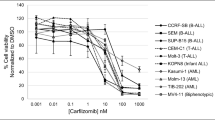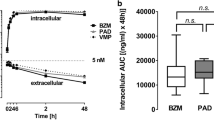Abstract
Bortezomib represents a new class of anti-cancer drugs, the proteasome inhibitors. We evaluated the in vitro activity of bortezomib with regard to tumour-type specificity and possible mechanisms of drug resistance in 115 samples of tumour cells from patients and in a cell-line panel, using the short-term fluorometric microculture cytotoxicity assay. Bortezomib generally showed dose–response curves with a steep slope. In patient cells, bortezomib was more active in haematological than in solid tumour samples. Myeloma and chronic myeloid leukaemia were the most sensitive tumour types although with great variability in drug response between the individual samples. Colorectal and kidney cancer samples were the least sensitive. In the cell-line panel, only small differences in response were seen between the different cell lines, and the proteasome inhibitors, lactacystin and MG 262, showed an activity pattern similar to that of bortezomib. The cell-line data suggest that resistance to bortezomib was not mediated by MRP-, PgP, GSH-; tubulin and topo II-associated MDR. Combination experiments indicated synergy between bortezomib and arsenic trioxide or irinotecan. The data support the current use of bortezomib but also points to its potential utility in other tumour types and in combination with cytotoxic drugs.




Similar content being viewed by others
References
Adams J, et al. Proteasome inhibitors: a novel class of potent and effective antitumor agents. Cancer Res. 1999;59:2615–22.
Voorhees PM, Orlowski RZ. The proteasome and proteasome inhibitors in cancer therapy. Annu Rev Pharmacol Toxicol. 2006;46:189–213. doi:10.1146/annurev.pharmtox.46.120604.141300.
Richardson PG, Mitsiades C, Hideshima T, Anderson KC. Proteasome inhibition in the treatment of cancer. Cell Cycle. 2005;4:290–6.
Fisher RI, et al. Multicenter phase II study of bortezomib in patients with relapsed or refractory mantle cell lymphoma. J Clin Oncol. 2006;24:4867–74. doi:10.1200/JCO.2006.07.9665.
Fridborg H, Jonsson E, Nygren P, Larsson R. Relationship between diagnosis-specific activity of cytotoxic drugs in fresh human tumour cells ex vivo and in the clinic. Eur J Cancer. 1999;35:424–32. doi:10.1016/S0959-8049(98)00286-X.
Larsson R, Kristensen J, Sandberg C, Nygren P. Laboratory determination of chemotherapeutic drug resistance in tumor cells from patients with leukemia, using a fluorometric microculture cytotoxicity assay (FMCA). Int J Cancer. 1992;50:177–85. doi:10.1002/ijc.2910500204.
Csoka K, et al. Cytotoxic drug sensitivity testing of tumor cells from patients with ovarian carcinoma using the fluorometric microculture cytotoxicity assay (FMCA). Gynecol Oncol. 1994;54:163–70. doi:10.1006/gyno.1994.1187.
Dhar S, et al. Anti-cancer drug characterisation using a human cell line panel representing defined types of drug resistance. Br J Cancer. 1996;74:888–96.
Rickardson L, et al. Screening of an annotated compound library for drug activity in a resistant myeloma cell line. Cancer Chemother Pharmacol. 2006;58:749–58. doi:10.1007/s00280-006-0216-7.
Chou TC, Talalay P. Quantitative analysis of dose–effect relationships: the combined effects of multiple drugs or enzyme inhibitors. Adv Enzyme Regul. 1984;22:27–55. doi:10.1016/0065-2571(84)90007-4.
Yu C, et al. The proteasome inhibitor bortezomib interacts synergistically with histone deacetylase inhibitors to induce apoptosis in Bcr/Abl+ cells sensitive and resistant to STI571. Blood. 2003;102:3765–74. doi:10.1182/blood-2003-03-0737.
Gatto S, et al. The proteasome inhibitor PS-341 inhibits growth and induces apoptosis in Bcr/Abl-positive cell lines sensitive and resistant to imatinib mesylate. Haematologica. 2003;88:853–63.
Dai Y, Rahmani M, Pei XY, Dent P, Grant S. Bortezomib and flavopiridol interact synergistically to induce apoptosis in chronic myeloid leukemia cells resistant to imatinib mesylate through both Bcr/Abl-dependent and -independent mechanisms. Blood. 2004;104:509–18. doi:10.1182/blood-2003-12-4121.
Heaney N, Pellicano F, Crawford L, Irvine S, Holyoake T.L. Bortezomib has anti-proliferative and apoptotic effects against CML stem cells, including the quiescent population. Blood. 2007;110: Abstract 2943.
Delic J, et al. The proteasome inhibitor lactacystin induces apoptosis and sensitizes chemo- and radioresistant human chronic lymphocytic leukaemia lymphocytes to TNF-alpha-initiated apoptosis. Br J Cancer. 1998;77:1103–7.
Adams J, Palombella VJ, Elliott PJ. Proteasome inhibition: a new strategy in cancer treatment. Invest New Drugs. 2000;18:109–21. doi:10.1023/A:1006321828515.
Duechler M, et al. In vitro cytotoxic effect of proteasome inhibitor bortezomib in combination with purine nucleoside analogues on chronic lymphocytic leukaemia cells. Eur J Haematol. 2005;74:407–17. doi:10.1111/j.1600-0609.2004.00406.x.
Goy A, et al. Phase II study of proteasome inhibitor bortezomib in relapsed or refractory B-cell non-Hodgkin’s lymphoma. J Clin Oncol. 2005;23:667–75. doi:10.1200/JCO.2005.03.108.
Faderl S, et al. Phase II study of single-agent bortezomib for the treatment of patients with fludarabine-refractory B-cell chronic lymphocytic leukemia. Cancer. 2006;107:916–24. doi:10.1002/cncr.22097.
Minderman H, Zhou Y, O’Loughlin KL, Baer . Bortezomib activity and in vitro interactions with anthracyclines and cytarabine in acute myeloid leukemia cells are independent of multidrug resistance mechanisms and p53 status. Cancer Chemother Pharmacol. 2007;60:245–55. doi:10.1007/s00280-006-0367-6.
Grabovsky Y, Tallarida RJ. Isobolographic analysis for combinations of a full and partial agonist: curved isoboles. J Pharmacol Exp Ther. 2004;310:981–6. doi:10.1124/jpet.104.067264.
Horton TM, et al. Bortezomib interactions with chemotherapy agents in acute leukemia in vitro. Cancer Chemother Pharmacol. 2006;58:13–23. doi:10.1007/s00280-005-0135-z.
Sondak VK, Korn EL, Morton DL, Kern DH. Testing chemotherapeutic combinations in the human tumor colony-forming assay. J Surg Oncol. 1988;37:156–60. doi:10.1002/jso.2930370304.
Liesveld JL, et al. Proteasome inhibitor combination with cytarabine or arsenic trioxide can potentiate apoptosis in AML cells. Blood. 2005;106: Abstract 4464.
Campbell R. Arsenic trioxide shows synergistic antimyeloma effect when combined with bortezomib and melphalan in vitro and helps overcome resistance of multiple myeloma cells to these treatments in vivo. Blood. 2004;104: Abstract 2467.
Wickstrom M, et al. Pharmacological profiling of disulfiram using human tumor cell lines and human tumor cells from patients. Biochem Pharmacol. 2007;73:25–33. doi:10.1016/j.bcp.2006.08.016.
Lindhagen E, et al. Pharmacological profiling of novel non-COX-inhibiting indole-pyran analogues of etodolac reveals high solid tumour activity of SDX-308 in vitro. Invest New Drugs. 2007;25:297–303. doi:10.1007/s10637-007-9049-4.
Wickstrom, M, et al. The novel alkylating prodrug J1: diagnosis directed activity profile ex vivo and combination analyses in vitro. Invest New Drugs. 2008;26(3):195–204.
Johnson JI, et al. Relationships between drug activity in NCI preclinical in vitro and in vivo models and early clinical trials. Br J Cancer. 2001;84:1424–31. doi:10.1054/bjoc.2001.1796.
Voskoglou-Nomikos T, Pater JL, Seymour L. Clinical predictive value of the in vitro cell line, human xenograft, and mouse allograft preclinical cancer models. Clin Cancer Res. 2003;9:4227–39.
Fuchs O. Differential induction of apoptosis in human leukemia cells (ML-1, ML-2, CTV-1 and KASUMI-1) exposed to the proteasome inhibitor bortezomib and the effects of transforming growth factor-beta signaling pathway. Blood. 2006;108: Abstract 4359.
Stapnes C, et al. The proteasome inhibitors bortezomib and PR-171 have antiproliferative and proapoptotic effects on primary human acute myeloid leukaemia cells. Br J Haematol. 2007;136:814–28. doi:10.1111/j.1365-2141.2007.06504.x.
Bosanquet AG, Nygren P, Weisenthal L.M. Individualized tumor response testing in leukemia and lymphoma. In G.J. Kaspers et al., editors. Innovative leukemia and lymphoma therapy. New York: Informa Health care; 2008, p 23–43.
Nygren P, Larsson R. Predictive tests for individualization of pharmacological cancer treatment. Exp Opin Med Diagn. 2008;2:1–12. doi:10.1517/17530059.2.1.1.
Wanlong M. Measurement and clinical relevance of proteasome enzymatic activity in plasma of patients with acute lymphoblastic leukaemia. Blood. 2006;108: Abstract 4475.
Wanlong M. Variations in proteasome enzymatic activities in plasma of patients with acute myeloid leukemia and myelodysplastic syndrome and their value in predicting clinical behaviour. Blood. 2006;108: Abstract 4497.
Wanlong M. Variations in proteasome enzymatic activities in plasma of patients with chronic lymphocytic leukaemia and their value in predicting clinical behaviour. Blood. 2006;108: Abstract 4946.
Kraus M, et al. Activity patterns of proteasome subunits reflect bortezomib sensitivity of hematologic malignancies and are variable in primary human leukemia cells. Leukemia. 2007;21:84–92. doi:10.1038/sj.leu.2404414.
Berenson JR, et al. A phase I/II study of arsenic trioxide/bortezomib/ascorbic acid combination therapy for the treatment of relapsed or refractory multiple myeloma. Clin Cancer Res. 2007;13:1762–8. doi:10.1158/1078-0432.CCR-06-1812.
Cusack JC Jr, et al. Enhanced chemosensitivity to CPT-11 with proteasome inhibitor PS-341: implications for systemic nuclear factor-kappaB inhibition. Cancer Res. 2001;61:3535–40.
Ryan DP, et al. A Phase I study of bortezomib plus irinotecan in patients with advanced solid tumors. Cancer. 2006;107:2688–97. doi:10.1002/cncr.22280.
Acknowledgments
The help from Lena Lenhammar, Sara Nissle, Linda Rickardsson and Dr Helena Jernberg-Wiklund is gratefully acknowledged. This work was supported by grants from the Swedish Cancer Society and the Swedish Research Council.
Author information
Authors and Affiliations
Corresponding author
Rights and permissions
About this article
Cite this article
Wiberg, K., Carlson, K., Åleskog, A. et al. In vitro activity of bortezomib in cultures of patient tumour cells—potential utility in haematological malignancies. Med Oncol 26, 193–201 (2009). https://doi.org/10.1007/s12032-008-9107-6
Received:
Accepted:
Published:
Issue Date:
DOI: https://doi.org/10.1007/s12032-008-9107-6




